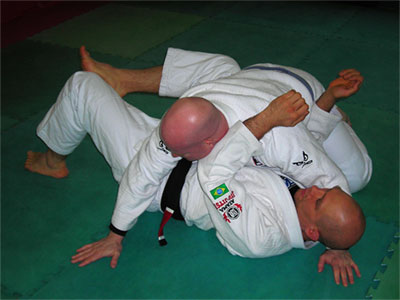I was recently helping someone with their sidemount escapes, and of course we had to discuss posture when trapped in side mount.
As I was working with this person we kept on returning to one particular detail: namely which part of your arm should you use when you are trying to get posture, to keep his weight off of you, and to make some space to move.
Consider the following picture of a very common sidemount escape posture:
 Notice how my hands aren’t holding onto my opponent – they are loose in the air. This is NOT how I used to position my arms when I first started using this posture. Back then I used to put my wrist and/or upper forearm under his chin and push up. Sometimes I also gripped my opponent’s deltoid with palm of my hand.
Notice how my hands aren’t holding onto my opponent – they are loose in the air. This is NOT how I used to position my arms when I first started using this posture. Back then I used to put my wrist and/or upper forearm under his chin and push up. Sometimes I also gripped my opponent’s deltoid with palm of my hand.
Many years later I use a superficially similar posture, but I try to push with the lower part of my forearm (closer to my elbow). It’s not a very big change – only 5 or 6 inches – but it makes a huge difference in escaping side mount…
First of all, pushing with the bottom part of your forearm means that you rely much more on the structural strength of your bones (specifically the humerus) and less on tricep strength. This makes it much harder for your opponent to collapse your framing arm simply by shifting his weight. Also using the bottom part of your forearm makes you less vulnerable to certain wristlocks.
This is one reason I love jiu-jitsu so much: little things make a huge difference. Changing the position of your hand by as little as one inch can take you from losing to winning a grappling match.
The post A Game of Inches appeared first on Grapplearts.
